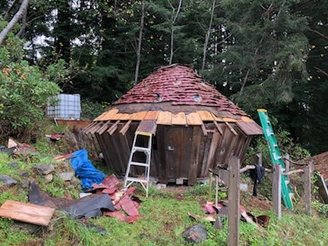
An early photo of the “Yurt” | Photos provided by CCAT
A somewhat historic outbuilding was torn down by Humboldt State University students earlier this semester, partly because the yurt-themed structure was deemed culturally insensitive.
Students with HSU’s Campus Center for Appropriate Technology first discussed the possibility of removing the “yurt” — located on the CCAT property next to the Behavioral and Social Sciences Building — last year, as it could be considered a form of appropriating Mongolian and Inner Asian cultures.

The “yurt” before it was completely demoed.
HSU’s student-run bilingual newspaper El Leñador first reported the news earlier this month, focusing mainly on the cultural appropriation aspect of the story. However, CCAT Co-Director Abbey Ramirez told the Outpost that the building was removed for several reasons.
“There were multiple reasons for taking it down, the primary reason being that this space, as well as the five garden beds next to it, have been agreed upon between CCAT and the Native American Studies Food Sovereignty Lab to be used as the FSL outdoor garden space, and no longer as a CCAT space,” Ramirez said. “With this new establishment of the FSL, it only became more and more blatant how the Mongolian yurt-styled structure was culturally inappropriate and odd to have in a space where traditional Wiyot food, practices, and culture will be centered. Other reasons for taking the building down had to do with structural and safety issues — particularly a rotting roof and floor.”
While keeping a Mongolian-themed yurt in a space that is now designated for the study of Indigenous natural resource management practices could be deemed culturally insensitive toward Indigenous Americans, CCAT representatives informed the Outpost that no people of Mongolian or Inner Asian heritage were asked what they thought of the structure.
In an effort to learn more about the issue, the Outpost reached out to UC Berkeley Tang Center for Silk Road Studies Program Director Franck Bille. Bille told the Outpost that he had never heard Mongolian people discuss cultural appropriation in the context of American-style yurts, which were popularized during the hippie movement of the 1960s and 70s and are now often used for “glamping” purposes across the country.
“Bear in mind that the yurt — ‘ger’ in Mongolian — is a dwelling that is found throughout the wider region of Inner Asia, including Kazakhstan and Kyrgyzstan,” Bille said.
Bille recommended that the Outpost pose this question to the public Facebook group “Mongolian Studies” to get a clearer understanding of how people of Mongolian heritage feel about American-made yurts.
The questions generated a few dozen responses on Facebook from people of Mongolian ancestry, many of whom expressed that the HSU “yurt” was too different from a traditional Mongolian ger to be considered a form of cultural appropriation. Group members also added that they’d like to see a more accurate, traditional yurt that include educational information about Mongolian and Inner Asian cultures.
With the “yurt” gone, HSU students are discussing a few different ideas for what to do with the empty space.
“There has been discussion about a traditional Wiyot structure being built, or potentially a greenhouse and toolshed,” Ramirez said.

No more “yurt.”
While the “yurt” was a popular gathering place for classes, workshops, meetings, interviews and recreational activities like art, yoga, and meditation for roughly 50 years, Ramirez said that CCAT’s decision has received overwhelming support from the campus community.
“We recognize that the Yurt-styled structure held many memories to CCAT and HSU alumni, and that its destruction lays heavy on the hearts of some,” she said. “However, CCAT has always been a body that operates by students for students, and the current student body of HSU is overwhelmingly supportive and happy with our decision and reasoning behind taking down the building. Moreover, CCAT has always been a place centered in learning and constant co-evolution, and sees the value of the intrinsic relationship between creation and destruction, death and rebirth. We hope to continue keeping up this extremely valuable passed-down legacy of co-evolution and learning, and that our predecessors are able to see the rebirth that is coming from the end of the structure’s standing.”
CLICK TO MANAGE